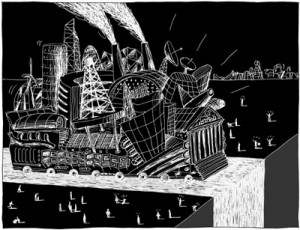 Here is another excerpt — part II — of the all consuming OpEd of the Sunday New York Times by Michael Lewis and David Einhorn:
Here is another excerpt — part II — of the all consuming OpEd of the Sunday New York Times by Michael Lewis and David Einhorn:
Excerpt:
When Bear Stearns failed, the government induced JPMorgan Chase to buy it by offering a knockdown price and guaranteeing Bear Stearns’s shakiest assets. Bear Stearns bondholders were made whole and its stockholders lost most of their money.
Then came the collapse of the government-sponsored entities, Fannie Mae and Freddie Mac, both promptly nationalized. Management was replaced, shareholders badly diluted, creditors left intact but with some uncertainty. Next came Lehman Brothers, which was, of course, allowed to go bankrupt. At first, the Treasury and the Federal Reserve claimed they had allowed Lehman to fail in order to signal that recklessly managed Wall Street firms did not all come with government guarantees; but then, when chaos ensued, and people started saying that letting Lehman fail was a dumb thing to have done, they changed their story and claimed they lacked the legal authority to rescue the firm.
But then a few days later A.I.G. failed, or tried to, yet was given the gift of life with enormous government loans. Washington Mutual and Wachovia promptly followed: the first was unceremoniously seized by the Treasury, wiping out both its creditors and shareholders; the second was batted around for a bit. Initially, the Treasury tried to persuade Citigroup to buy it — again at a knockdown price and with a guarantee of the bad assets. (The Bear Stearns model.) Eventually, Wachovia went to Wells Fargo, after the Internal Revenue Service jumped in and sweetened the pot with a tax subsidy.
In the middle of all this, Treasury Secretary Henry M. Paulson Jr. persuaded Congress that he needed $700 billion to buy distressed assets from banks — telling the senators and representatives that if they didn’t give him the money the stock market would collapse. Once handed the money, he abandoned his promised strategy, and instead of buying assets at market prices, began to overpay for preferred stocks in the banks themselves. Which is to say that he essentially began giving away billions of dollars to Citigroup, Morgan Stanley, Goldman Sachs and a few others unnaturally selected for survival. The stock market fell anyway.
It’s hard to know what Mr. Paulson was thinking as he never really had to explain himself, at least not in public. But the general idea appears to be that if you give the banks capital they will in turn use it to make loans in order to stimulate the economy. Never mind that if you want banks to make smart, prudent loans, you probably shouldn’t give money to bankers who sunk themselves by making a lot of stupid, imprudent ones. If you want banks to re-lend the money, you need to provide them not with preferred stock, which is essentially a loan, but with tangible common equity — so that they might write off their losses, resolve their troubled assets and then begin to make new loans, something they won’t be able to do until they’re confident in their own balance sheets. But as it happened, the banks took the taxpayer money and just sat on it.
>
Source:
The End of the Financial World As We Know It
MICHAEL LEWIS and DAVID EINHORN
NYT, January 3, 2009
http://www.nytimes.com/2009/01/04/opinion/04lewiseinhorn.html
How to Repair a Broken Financial World
MICHAEL LEWIS and DAVID EINHORN
NYT, January 3, 2009
http://www.nytimes.com/2009/01/04/opinion/04lewiseinhornb.html


What's been said:
Discussions found on the web: